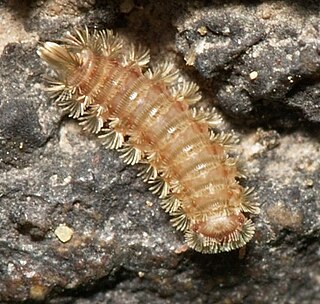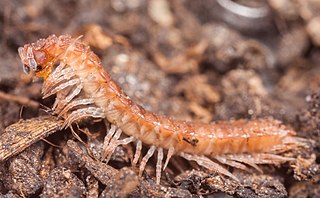
Polydesmida is the largest order of millipedes, containing approximately 3,500 species, including all the millipedes reported to produce hydrogen cyanide (HCN). Polydesmids grow and develop through a series of moults, adding segments until they reach a fixed number in the adult stage, which is usually the same for a given sex in a given species, at which point the moulting and the addition of segments and legs stop. This mode of development, known as teloanamorphosis, distinguishes this order from most other orders of millipedes, which usually continue to moult as adults, developing through either euanamorphosis or hemianamorphosis.

Polyxenida is an order of millipedes readily distinguished by a unique body plan consisting of a soft, non-calcified body ornamented with tufts of bristles – traits that have inspired the common names "bristly millipedes" or "pincushion millipedes". There are at least 86 species in four families worldwide, and are the only living members of the subclass Penicillata.

Glomeridesmida is an order of millipedes in the infraclass Pentazonia containing 2 families and at least 31 species. Glomeridesmida is the only living order of the superorder Limacomorpha. Also known as slug millipedes, glomeridesmidans are small and somewhat flattened, and unlike other orders of Pentazonia, are unable to roll into a ball. Ocelli (eyes) are absent.

Chordeumatida is a large order of millipedes containing some 1200 species with a nearly worldwide distribution. Also known as sausage millipedes, they grow and develop through a series of moults, adding segments until they reach a fixed number in the adult stage, which is usually the same for a given sex in a given species, at which point the moulting and the addition of segments and legs stop. This mode of development, known as teloanamorphosis, distinguishes this order from most other orders of millipedes, which usually continue to moult as adults, developing through either euanamorphosis or hemianamorphosis.

Urochordeuma is a genus of millipedes in the order Chordeumatida and the only genus in the family Urochordeumatidae. Adult millipedes in this family have 30 segments. The two species are known from the U.S. state of Washington, where U. bumpusi is known from Pierce County, and U. porona from King County.
Haplogona is a genus of chordeumatidan millipedes and the only genus in the family Verhoeffiidae. Adult millipedes in this family have 30 segments. These species occur in the southern Alps of Europe, from Genoa, Italy to the Istrian peninsula.

Polydesmidae is a family of millipedes in the order Polydesmida. These millipedes range from 4 mm to 30 mm in length. This family includes species notable for featuring sexual dimorphism in segment number: Adult females in the genus Perapolydesmus have the usual 20 segments, but the adult males have only 19.
Glomeridesmidae is a millipede family of the order Glomeridesmida. This family includes two genera: The genus Glomeridesmus includes most species in this family; the genus Glomeridesmoides includes one species.
Tetramerocerata is an order of pauropods containing 12 different families and about 480 different species. Tetrameroceratans have a 12 segmented body, 4 segmented antennae, 6 tergites, and 8 to 10 pairs of legs as adults. Most pauropods in this order have 9 leg pairs as adults, but four genera have only 8 pairs, and adult females in the genus Decapauropus have either 9 or 10 pairs of legs. Pauropods in this order are generally 0.5 mm to 2 mm long, and are usually white or brown. Tetramerocerata has a subcosmopolitan distribution, occurring nearly worldwide.
Brachypauropodidae is a family of pauropods. Like most adult pauropods in the order Tetramerocerata, most adults in this family have 9 pairs of legs, but adults in a few species in two genera, Aletopauropus and Zygopauropus, have only 8 pairs of legs.

Cleidogonidae is a family of millipedes in the order Chordeumatida. Adult millipedes in this family have 28, 29, or 30 segments. This family includes the genus Tianella, notable for featuring adult millipedes with 29 segments, a number not found in the adults of any other chordeumatidan species. Adults in most Tianella species have 29 segments, but adults in two have only 28 segments. In the Tianella species with 29 segments, adult females have 48 pairs of legs, as one would expect in adult female chordeumatidans with one segment fewer than the 30 usually found in this order. There are seven genera and at least 140 described species in Cleidogonidae.
Rhiscosomides is a genus of millipedes in the order Chordeumatida with seven described species, and is the only genus in the family Rhiscosomididae. Adult millipedes in this family have 30 segments.

Metopidiotrichidae is a family of millipedes in the order Chordeumatida. These millipedes range from 4 mm to 17 mm in length. Adult millipedes in this family have 32 segments, not the 30 segments usually found in this order. Adult males in this family often feature a reduced or vestigial leg pair 10 as part of the gonopod complex, in addition to the two leg pairs typically modified into gonopods in this order. There are about 9 genera and at least 70 described species in Metopidiotrichidae.
Chordeumatidae is a family of millipedes belonging to the order Chordeumatida. These millipedes range from 7 mm to 18 mm in length and are found in Europe. Adult millipedes in this family have either 28 or 30 segments. This family features distinctive sex-linked modifications to the legs in adults: In the adult female, a legless sternite replaces the third pair of legs, and in the adult male, five pairs of legs are modified in the gonopod complex. These modifications are more extensive than those found in other adult males in this order, which often have only two leg pairs modified into gonopods. With the more extensive modifications to the legs in this family, species with the usual 30 segments feature adult females with only 49 leg pairs and adult males with only 45 pairs of walking legs, and species with only 28 segments feature adult females with only 45 leg pairs and adult males with only 41 pairs of walking legs.
Speophilosomatidae is a family of millipedes belonging to the order Chordeumatida. These millipedes are found in Japan and range from 4 mm to 6 mm in length. Adult millipedes in this family are notable for being among the few in this order with only 26 segments instead of the 30 usually found in chordeumatidans. The adult males in this family are also notable for involving three leg pairs in the gonopod complex rather than the two pairs typically modified into gonopods in this order.
Peterjohnsiidae is a small family of millipedes belonging to the order Chordeumatida. The family was first described in 1987 by Jean-Paul Mauriès. These millipedes range from 3 mm to 8 mm in length and are found in Australia. Species in this family exhibit sexual dimorphism in segment number: adult males have 30 segments, but adult females have 32 segments. In adult males in this family, the gonopod complex involves three leg pairs rather than just the two usually modified into gonopods in this order.
Haaseidae is a family of millipedes belonging to the order Chordeumatida. Adult millipedes in this family range from 4.5 mm to 12 mm in length and have either 28 or 30 segments. For example, Orobainosoma hungaricum orientale, a subspecies of Haasea hungarica, has only 28 segments in adults rather than the 30 usually found in chordeumatidan adults, with only 46 pairs of legs in adult females and only 44 pairs of walking legs in adult males.
Hoffmaneumatidae is a family of millipedes belonging to the order Chordeumatida. This family includes two genera, one (Hoffmaneuma) found in the Russian Far East and the other (Japanoparvus) found in Japan. Millipedes in this family range from 4 mm to 6 mm in length. Adult millipedes in this family have only 28 segments, not the 30 segments usually found in this order. Adult males in this family feature a reduced leg pair 10 in addition to the two pairs normally modified into gonopods in this order. In the adult male of the species Hoffmaneuma exiguum, for example, the gonopod complex derives from all three leg pairs rather than from just the usual two.
Opisthocheiridae is a family of millipedes belonging to the order Chordeumatida. These millipedes range from 5 mm to 16 mm in length and are found from Belgium to Morocco. Adult millipedes in this family have 26 or 30 segments. This family includes the cave-dwelling species Opisthocheiron canayerensis, notable as one of few chordeumatidan species with only 26 segments. The adult female of this species has only 42 pairs of legs, and the adult male has only 40 leg pairs, as one would expect for adult chordeumatidans with four fewer segments than typically found in this order.

Brachydesmus superus, sometimes called the flat millipede, is a species of millipede in the family Polydesmidae. Its specific name is from the Latin word for "above, upper," because it lives in the upper soil layer.









